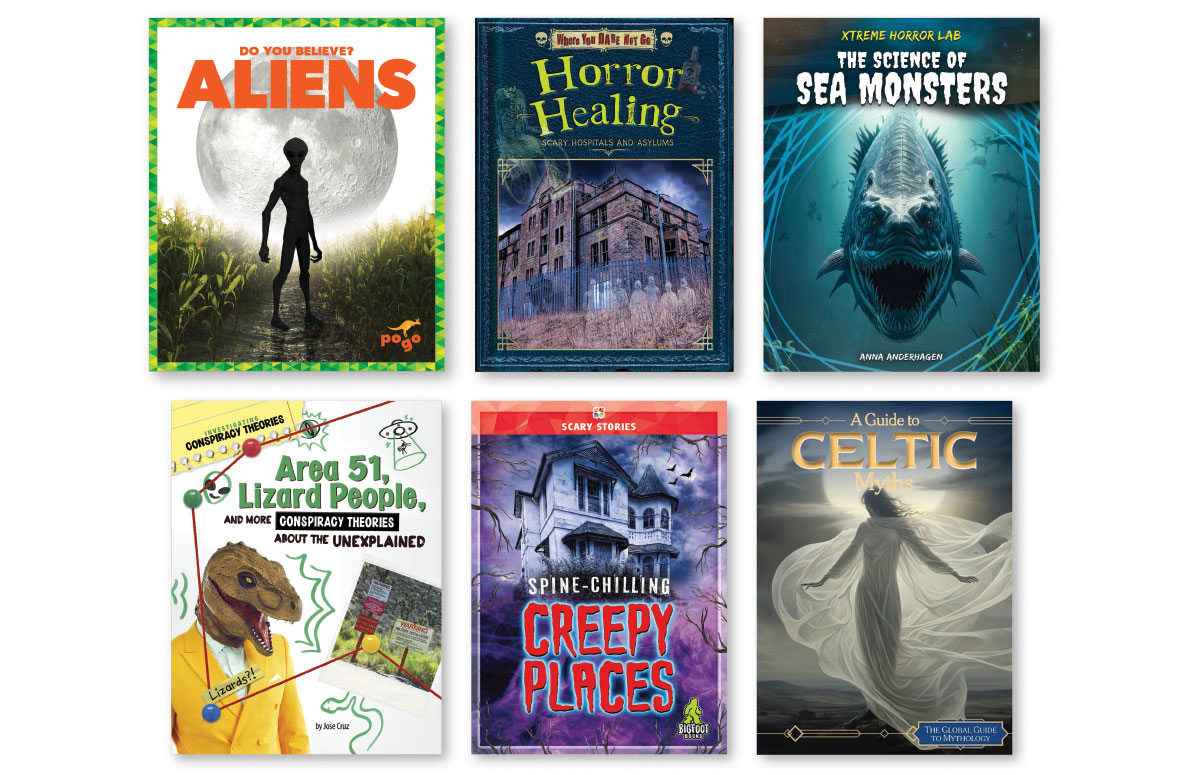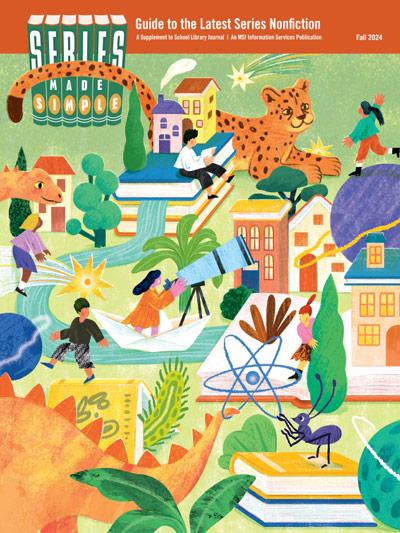A Chill in the Air | Myths & Mysteries Series Nonfiction
Mythical heroes and spine-chilling creatures await readers in these fascinating series.

We expect autumn to bring changes. Temperatures dip, requiring that we bundle up a bit more. Baseball season shifts to football fandom. The landscape changes before our eyes. This fall, the publishing scene is rife with excitement, too. Students will be eager to read this season’s new titles featuring timeless myths and heroes. Some series offer new, sometimes scientific, perspectives on fascinating conundrums, phenomena, and mythical beings that may or may not be real. Others challenge readers to face up to scary, spooky stories about ghosts, monsters, vampires, zombies, and so on. Like autumn leaves, the leaves of these books will turn—with reader anticipation, chills, and excitement.
Elementary
Deniston, Natalie. Aliens. ISBN 9798892132152.
––––. Area 51. ISBN 9798892132183.
––––. Bermuda Triangle. ISBN 9798892132213.
––––. Bigfoot. ISBN 9798892132244.
––––. Loch Ness Monster. ISBN 9798892132275.
––––. Stonehenge. ISBN 9798892132305.
ea vol: 24p. (Do You Believe?). Jump!/Pogo. Aug. 2024. Tr. $18.95.
Gr 3-5–Though brief, the titles in this series contain enough information to whet the appetites and curiosity of readers. Each volume starts with helpful suggestions for adults on how to support reading navigating the text and ask questions as they read. Sentences are short but read smoothly, striving readers will feel welcome. New vocabulary is set in white boldface and defined in the glossary; no pronunciation guides are included. At each title’s conclusion students are encouraged to think critically: Is the volume’s phenomenon real or not? The series takes no positions. The books are visually appealing, with high-quality photos, colorful chapter headings, and text set against contrasting backgrounds. Photos depict racial diversity. Maps and charts are used as needed, and information is current up to 2024. Sidebars, charts, and timelines offer addition information. VERDICT Recommended for schools and public libraries. An attractive, informative, well-presented series with appealing topics.
Upper Elementary to Middle School
Allen, Judy & Dinah Williams. Alarming Afterlife: Scary Cemeteries and Graveyards. ISBN 9798892320719.
Giannini, Alex & Dinah Williams. Hauntings at Home: Scary Houses and Farms. ISBN 9798892320733.
Lunis, Natalie & Sarah Parvis. Startling Stay: Scary Hotels and Inns. ISBN 9798892320764.
Lunis, Natalie & Troy Taylor. Eerie Education: Scary Schools and Libraries. ISBN 9798892320726.
Markovics, Joyce & Dinah Williams. Petrifying Playtime: Scary Amusement Parks and Playgrounds. ISBN 9798892320757.
Williams, Dinah. Horror Healing: Scary Hospitals and Asylums. ISBN 9798892320740.
ea vol: 48p. (Where You Dare Not Go). Bearport/Ursa. Aug. 2024. Tr. $22.95.
Gr 4-7–Readers won’t hesitate to “dare” venture into this thrilling series. Eighteen brief, chilling tales per volume make for suspenseful reading, and the “true story” element makes them all the more compelling. Spooky-looking covers resemble leather-bound books, and sepia-toned images supplement the text and ramp up the fright factor. Text is set against a background resembling tattered antique parchment. Some pages bear insect images, upping the “ick” quotient. Sidebars resembling dark-gray “clouds” provide additional information. Back matter includes maps, a glossary, a bibliography, and a QR code that leads to further reading (including the publisher’s website), and an index. Some volumes include bloody details. Caution: Horror Healings might be especially disturbing for sensitive readers, with accounts of brutal and/or gruesome “treatments” for mental patients. VERDICT Students will find much to appreciate in this engrossing series recommended for schools and public collections.
Anderhagen, Anna. The Science of Sea Monsters. ISBN 9781098293222.
––––. The Science of Vampires. ISBN 9781098293239.
––––. The Science of Werewolves. ISBN 9781098293246.
––––. The Science of Zombies. ISBN 9781098293253.
Daniels, Ruby. The Science of Ghosts. ISBN 9781098293208.
––––. The Science of Psychic Powers. ISBN 9781098293215.
ea vol: 48p. (Xtreme Horror Lab). ABDO/A&D Xtreme. Sept. 2024. Tr. $35.64.
Gr 4-7–This series takes a rational, scientific approach to cryptids, monsters, and the paranormal. Commendably, it doesn’t debunk these phenomena, nor does it talk down to or ridicule believers. Short sentences promote fast-paced reading, ramp up suspense, and welcome striving readers. New vocabulary appears in boldface and is defined in the glossary. Volumes provide interesting historical information about what different cultures believe or believed about these phenomena. One chapter in each title brings investigations of the particular topic into the present day and explains what modern tools are used to investigate/explore it, and what some people believe and why. A subsequent chapter provides scientific, real-world explanations for the phenomenon. The series benefits from attractive design and visuals. Note: The vampire and zombies titles are a bit gruesome. VERDICT An appealing series recommended for schools and public collections.
Cruz, Jose. Area 51, Lizard People, and More Conspiracy Theories About the Unexplained. ISBN 9781669077329.
Hunter, Nick. A Fake Moon Landing, Alien Life Secrets, and More Conspiracy Theories About Space. ISBN 9781669077404.
Simpson, Phillip W. Fake Birds, Flat Earth, and More Conspiracy Theories About Our Planet. ISBN 9781669077480.
––––. Wartime Secrets, Assassination Plots, and More Conspiracy Theories About U.S. History. ISBN 9781669077565.
ea vol: 32p. (Investigating Conspiracy Theories). Capstone. Aug. 2024. Tr. $31.32.
Gr 5-8–People are intrigued by conspiracy theories—even if they don’t believe them. This well-done series, written in a conversational tone, will quickly grab and hold readers’ attention and help students learn to think about and question what they read and hear. Each title covers four conspiracy theories, a term that is defined early on. Chapters discuss how such theories start and are maintained, what researchers say, and how they’re debunked. Some examples are ludicrous and might make students chuckle while reading. However, the series admits some (more plausible sounding) theories are difficult to disprove and give pause, which allows scientists to ask questions and find out more. An important feature in each book poses questions that provide valuable ideas for student consideration. The series is visually attractive, with black-and-white and color photos and helpful captions. Some artwork is cartoonish, e.g., aliens and reptiles, and maps are included when needed. VERDICT Recommended for schools and public libraries. Absorbing, solidly evidence-based, and thought-provoking.
Mason, Jenny. Spine-Chilling Creepy Places. ISBN 9781645198352.
––––. Spine-Chilling Ghostly Sightings. ISBN 9781645198369.
––––. Spine-Chilling Haunted History. ISBN 9781645198376.
––––. Spine-Chilling Legends and Myths. ISBN 9781645198383.
––––. Spine-Chilling Paranormal Events. ISBN 9781645198390.
––––. Spine-Chilling Spooky Things. ISBN 9781645198406.
ea vol: 32p. (Scary Stories). Kaleidoscope/Bigfoot. Aug. 2024. Tr. $28.95.
Gr 4-6–Students will find well-written accounts that live up to the series title. Short sentences—sometimes, not even full sentences, just brief, terse phrases that heighten suspense—grab readers and will keep them turning pages. Each atmospheric title opens with a brief introduction that sets the spooky stage for what’s to come. Graphics and book design add to the series’ overall sense of dread: chapter headings are printed in bold red capital letters, creepy inset photos and occasional scattered “blood droplets” on pages add to the ambiance. Each volume includes a double-page spread related to its topic, for example, Creepy Places features “The Most Haunted Places in the World,” with a world map and thumbnail photos featuring the locations. Some nods to Indigenous cultural beliefs are included. Sidebars and critical thinking questions add contours to the information, and vocabulary words are printed in a thematic red, with definitions in the glossary. VERDICT Intriguing, appealing topics. Recommended for school and public library collections.
Upper Middle School to High School
Barrow, Johanna. A Guide to Greek Myths. ISBN 9781502672193.
Holt, Amy. A Guide to Chinese Myths. ISBN 9781502672315.
Lombardo, Jennifer. A Guide to Celtic Myths. ISBN 9781502672285.
––––. A Guide to Mesoamerican Myths. ISBN 9781502672162.
––––. A Guide to Native American Myths. ISBN 9781502672131.
––––. A Guide to Roman Myths. ISBN 9781502672254.
Thorpe, Judy. A Guide to African Myths. ISBN 9781502672100.
Washburne, Sophie. A Guide to Egyptian Myths. ISBN 9781502672223.
ea vol: 48p. (The Global Guide to Mythology). Cavendish Square. Jul. 2024. Tr. $33.07.
Gr 6-9–Over millennia, people shared similar values, fears, concerns, and cultural attitudes, and the stories they told and passed down conveyed these ideas within their societies. Each book in this series opens with an introduction the nation of origin and/or culture that produced a set of myths. Students learn that myths share some cross-cultural thematic similarities in trope (creation myths, hero tales, flood tales, tricksters, myths explaining natural phenomena), in function (myths also entertain and teach lessons), and in characterization. While some of these concepts are heady and thought-provoking, the myths included here are entertaining, wistful, exciting, and humorous. Each volume summarizes the culture’s belief and traditions, and students will learn some history along the way. The series is clearly written, although pronunciation guides would have helped. A blend of photographs, maps, charts, and illustrations of artworks representative of individual cultures lend strong visual appeal. Sidebars and captions offer additional information, and each chapter ends with some critical thinking questions. Back matter includes a glossary, an index, and a bibliography. VERDICT Highly recommended for school and public library collections.
Lin, Joy. The Science Behind Mermaids, Werewolves, and Bigfoot. ISBN 9781538294246.
––––. The Science Behind Unicorns, Dragons, and Kraken. ISBN 9781538294277.
––––. The Science Behind Vampires, Witches, and Ghosts. ISBN 9781538294307.
ea vol: 32p. (Monster Science). Gareth Stevens. Aug. 2024. Tr. $28.27.
Gr 6-9–This fascinating UK import presents scientific facts and plausible explanations as to why cryptids and other mythical beings can’t be real, and offers fresh perspectives on these creatures that students may not have previously considered. The series claims it is “here to help you by sorting truth from myth and examining the scientific truth.” Each title delivers factual information about the creatures, includes real-life examples of animals that have attributes of the cryptids, and offers clearly labeled diagrams demonstrating scientific processes. Students will learn what humans actually observed in the past when they claimed they saw the alleged beings. Volumes also discuss the historical, mythological, and folkloric backgrounds/underpinnings of cryptid tales, helping students understand such stories have existed for centuries. This thought-provoking series benefits from humorous, cartoonish illustrations, and diagrams demonstrating scientific principles. VERDICT A well-done, entertaining series that examines cryptids scientifically. Highly recommended for schools and public collections.
“Do You Believe?” (Jump!/Pogo) lets students decide what they think about mysterious subjects including aliens, Bigfoot, and the Loch Ness Monster. Cavendish Square’s impressive “Global Guide to Mythology” features eight compilations of myths featuring heroes from various cultures. Middle schoolers intrigued by bizarre “explanations” of events and phenomena will appreciate Capstone’s “Investigating Conspiracy Theories.” Readers will encounter tales that live up to their series titles in “Scary Stories” (Kaleidoscope/Bigfoot) and “Where You Dare Not Go,” (Bearport/Ursa). “Monster Science” (Gareth Stevens) offers solid scientific evidence for science-minded readers as to why cryptids can’t be real.
|
RELATED
The job outlook in 2030: Librarians will be in demand
The job outlook in 2030: Librarians will be in demand
ALREADY A SUBSCRIBER? LOG IN
We are currently offering this content for free. Sign up now to activate your personal profile, where you can save articles for future viewing







Add Comment :-
Be the first reader to comment.
Comment Policy:
Comment should not be empty !!!